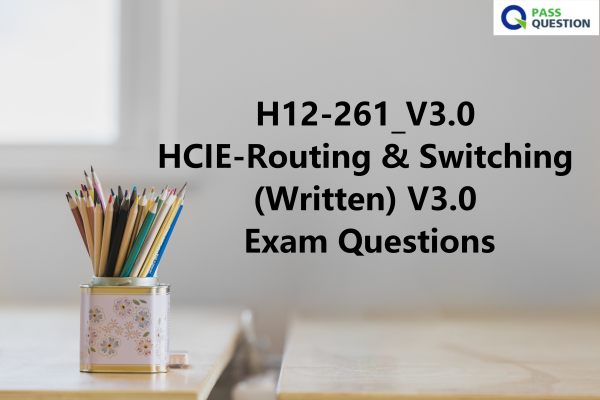H12-261_V3.0 HCIE-Routing & Switching (Written) V3.0 Exam Questions
If you are preparing for HCIE-Routing & Switching (Written) V3.0 exam, PassQuestion provides the latest H12-261_V3.0 HCIE-Routing & Switching (Written) V3.0 Exam Questions which contain the latest exam knowledge content to pass your Huawei H12-261_V3.0 exam successfully. Our H12-261_V3.0 HCIE-Routing & Switching (Written) V3.0 Exam Questions will help you to pass the Huawei H12-261_V3.0 exam smoothly, so make sure to use the H12-261_V3.0 HCIE-Routing & Switching (Written) V3.0 Exam Questions in all modes to improve your preparation. You are guaranteed to pass your HCIE-Routing & Switching V3.0 Certification Exam easily.

HCIE-Routing & Switching
HCIE-Routing & Switching certify you have a comprehensive and thorough understanding of large networks, including technologies used in complex large and medium-sized networks, and the ability to design various enterprise networks independently and implement those designs using Huawei routing and switching devices.It is recommended that you learn HCIP-Routing & Switching in advance. Five years relevant work experience is suggested.
HCIE-Routing & Switching V3.0 Certification Exam Information
- Exam Name: HCIE-Routing & Switching (Written)
- Exam Code: H12-261
- Exam Type: Written examination
- Exam Format: Single Answer, Multiple Answer, True-false Question, Fill in the blank answers, Drag and Drop Item
- Time: 90min
- Passing Score/Total Score: 600/1000
- Exam Cost: 300USD
- Language: Chinese,English
HCIE-Routing & Switching V3.0 Exam Knowledge Objectives
- 1.Layer 2 Technologies 12%
- 2.IPv4/v6 Unicast 52%
- 3.MPLS VPN 10%
- 4.IPv4/v6 Multicast 6%
- 5.Network Security 5%
- 6.QoS 5%
- 7.Network Management 2%
- 8.Features 3%
- 9.SDN 5%
View Online HCIE-Routing & Switching (Written) V3.0 H12-261_V3.0 Free Questions
VRRP packets are encapsulated in IP packets and sent to 224.0.0.8. The TTL value is 255, and the protocol number is 112.
A.True
B.False
Answer: B
If a port configure with stp loop-protection stops receiving BPDUs, which of the following states will the port be put into?
A. Forwarding.
B. None of all.
C. Discarding.
D. Learning.
Answer: C
Which of these best identifies the types of prefixes a router running BGP will advertise to an IBGP peer?
A. Prefixes in its IP routing table.
B. Prefixes received from IBGP and EBGP peers.
C. All prefixes locally originated via network or import to BGP.
D. Prefixes received from IBGP and be in its IP routing table.
Answer: C
How many bits dose EXP occupy in the MPLS label header?
A. 3
B. 2
C. 1
D. 4
Answer: A
STP Root Bridge selection is based on which of the following?
A. MAC address
B. Bridge Priority
C. Cost of interfaces
D. Bridge Priority and MAC address
Answer: D
Which of the following statements about FR mapping are correct?
A. When LMI is disabled, Inverse ARP works properly.
B. On Huawei VRP inverse ARP is disabled by default.
C. Dynamic address mapping maps the known DLC! to the next hop through FR Inverse ARP.
D. Static mapping needs to be configured even if Inverse ARP is enabled.
Answer: A
In which state can BGP peers send keepalive messages?
A. Established
B. OpenConfirm
C. OpenSent
D. Connect
Answer: C
- TOP 50 Exam Questions
-
Exam
All copyrights reserved 2025 PassQuestion NETWORK CO.,LIMITED. All Rights Reserved.

